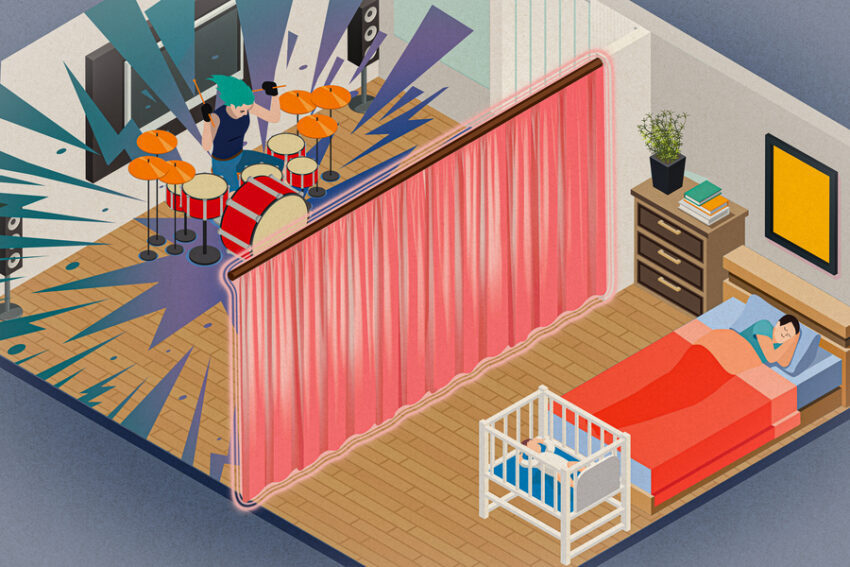Beyond the Clickbait: The MIT “Sound Curtain”
If you are at all interested in audio, you surely had the article detailing the research out of MIT about a new sound curtain come across your feed. It shows an image that looks like this:

That looks pretty amazing. Just hang a curtain and you can sleep in the same room as a drummer (presumably playing at full volume). What’s the story here? How does it work? When can you buy it? Let’s discuss!
The Clickbait
The clickbait is clear. You can hang a special curtain and it will stop all sound from traveling through it. Wrap it around you like a blanket and you’ll be in a cocoon of silence. A cone of silence, if you will. Finally, you’ll be able to work in peace by wrapping your cubical in this new, space-age fabric. You’ll be able to play your home theater as loud as you want without worrying about your neighbors. All by simply hanging some fabric! It’s a dream come true!
The Reality
Well, it’s a dream alright. The MIT News article has a link to the original research but you don’t even have to click that to get the full scoop. Most of the clickbait that is out there comes from people (or AI) who didn’t bother to read the full article to understand what is actually happening.
The Science
The science is fairly simple. The researchers took silk and combined it with “thermally drawn piezoelectric polymer-based fibers.” What this does is allow the researchers to add voltage to the fabric to make it vibrate. If that sounds a lot like what a speaker driver does, you are correct. They then used this technology to vibrate the fabric to combat sound waves created by a speaker that was 30cm (just under a foot) away as measured by a microphone usually 2.5 or 3cm away from the other side of the fabric.
They tested two different methods for combating sound. The first was to create an inverse wave to cancel the created sound. This works much like your active noise-cancelling headphones. The second method was to control the vibrations of the fabric so that the fabric stayed still when it was hit with a sound wave. Soundwaves travel through the air by vibrations. If the air cannot vibrate the fabric, then the soundwave will not propagate through the fabric to the air on the other side.
Results
The results of the testing were pretty impressive. The researchers showed up to a 65dB decrease in sound on the other side of the curtain using the first “active noise canceling” method. Using the second “keep the fabric still” method, sound transmission was reduced up to 75%. Of course, we need to look at the test conditions. The speaker was placed nearly a foot from the fabric and the mic was a mere inch away from the other side. The fabric was not freely hung for the most impressive results. It was suspended in a frame so that it was held tight. Lastly, the researchers state that more powerful processing and different fabric designs will be needed to control more complex sounds.
What Does it Mean for You?
As you might expect with research, they kept the tests fairly simple in order to show how effective this electric, vibrating fabric could be. They were not using complex sounds for most of the tests, but test tones. The microphone being placed so close to the fabric ensured that they could reveal how much the fabric could mitigate the sounds.
In the real world, the image being shown would never work. Free-hanging fabric would never be effective enough to keep a space quiet enough for a drummer to be within a few feet of you while you slept. The fabric would have to be suspended at the very least. There is also no way that the fabric could stop sound flanking paths. Any gap around the fabric would let sound pass through. Sound will also pass freely though structures and into the air of the room regardless of the positioning of the curtain. Will the curtain quiet a room? Sure. Just like rolling up the windows of your car quiets the outside noise. But it will not silence a space and it will take more than just hanging it in a room to be effective.

Additional Considerations
Lastly, there are a lot of other considerations that many clickbait articles do not take into account when they report on the MIT “sound curtain.” First, this is not just a curtain. There will be electronics involved including some sort of processor, at least a few microphones, and a way to power the curtain. The curtain itself wouldn’t look much like a curtain to you. Here is how they prepared it:
Each fabric was ironed and then lightly tensioned in an embroidery hoop. A 6.7 cm acoustic fiber was then stitched onto the center of the fabric. An acrylic ring was epoxied to the face of the fabric and then it was set upside down for 24 h. Then, a 11 cm outer diameter, 8 cm inner diameter, 1.5 mm thick acrylic ring was epoxied on the back. An 11 cm diameter acrylic plate and a 200 g weight placed on top provided the force of tension while the epoxy cured for 24 h. The ring was then cut out of the excess fabric and placed in a metal frame.
Single Layer Silk and Cotton Woven Fabrics for Acoustic Emission and Active Sound Suppression
While they don’t have pictures of the fabric, what they essentially created was a driver. The ring may have loose fabric in the center, but it isn’t pleated like a normal curtain and is suspended in a metal frame. If you have ever tried active noise-canceling headphones, you have a good idea of how well this technology would work in a real-world application. It would be okay at reducing background hums and other droning noises but fairly terrible at everything else.
Conclusion
In short, the MIT “sound curtain” is a cool technology that may have some real-world applications eventually. It is a long way off from being in your home and won’t do nearly what the clickbait articles suggest. The “sound curtain” may reduce some sounds (great for people who live near a highway for example) but won’t fully or even partially stop sound transmission from flanking paths. It is important to note that the researchers didn’t create the clickbait image. They are doing research that could eventually lead to interesting products. It is the terrible reporters and marketing team that twist this stuff in order to get you to click.


